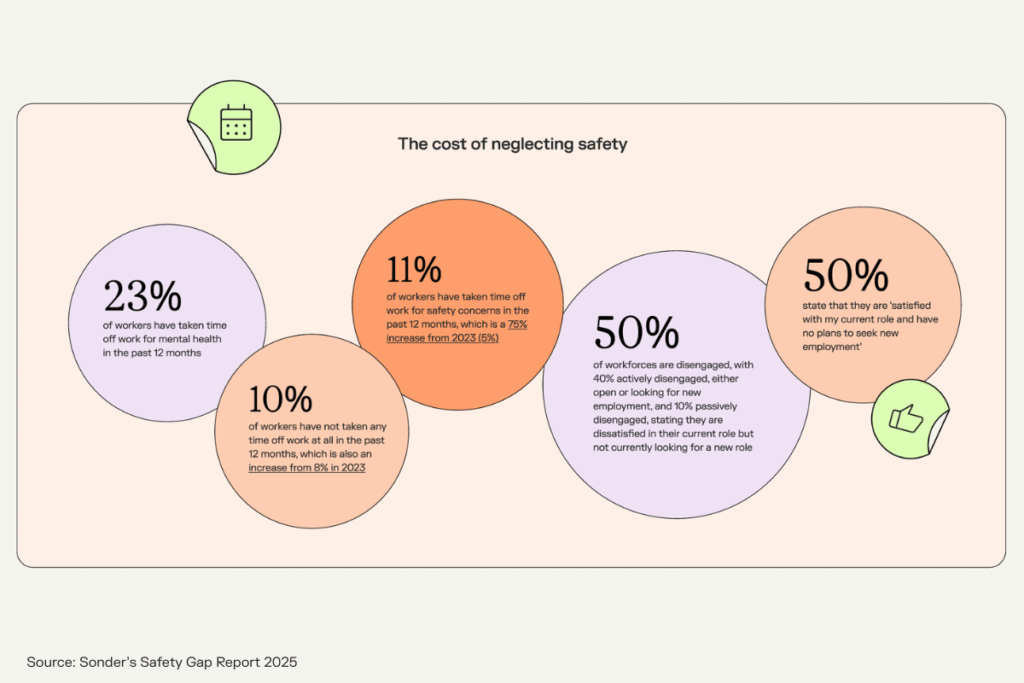You walk into the office and immediately sense tension in the air. Some team members look drained or distracted, others seem on edge or perhaps frustrated over minor issues. Something feels off — but it’s not always clear what’s causing it or how to help.
What you’re noticing could be the result of exposure to traumatic events or materials in the workplace, a type of psychosocial hazard that can affect employees in many roles.
For some positions, distressing experiences are an inherent part of the job. This can look like a serious workplace accident, a violent incident, or repeated exposure to upsetting content. But other times, these hazards are less obvious, appearing as repeated customer aggression, hearing distressing stories during a claims process, or interacting indirectly with traumatic material.
According to Safe Work Australia, exposure is more likely to be traumatic when it is unexpected, feels uncontrollable, or stems from intentional cruelty. It becomes a hazard when it is severe, prolonged, or frequent — leaving a lasting impact on employees’ wellbeing, team dynamics, and the overall culture of your organisation.
For HR managers and senior leaders, this isn’t just about compliance. It’s about understanding what your people are experiencing in the workplace, recognising risks early, and taking practical steps to support them. This in turn protects not only their wellbeing but the resilience and performance of the entire team.
In this article, we’ll explore how to recognise traumatic events or materials, manage the risks, and embed prevention strategies that support both your people and your business.
This is part of a series on understanding psychosocial hazards. Other features in the series include:
- Understanding the risk and impact of poor role clarity
- Understanding the risk and impact of imbalanced job demands
- Harmful behaviour in the workplace and how to navigate it
Disclaimer: The information contained in this article and on this website is general information only and does not constitute legal advice. Although all efforts have been made to ensure the accuracy and currency of the information presented, Sonder takes no responsibility for any errors or omissions presented. Please contact a legal representative for individual advice.
What is a traumatic event or material, and why does it matter?
Traumatic events or material are situations or content that expose workers to distressing, graphic, or emotionally overwhelming experiences. This might involve directly witnessing trauma, such as workplace accidents or acts of violence, or being indirectly exposed through stories, images, or recordings of such events.
For many workers, these experiences don’t stay at work, they can follow them home, shaping sleep, relationships, and mental health. Over time, the cumulative impact can be profound.
For organisations, the risks are twofold:
- Human impact: Employees experience stress, burnout, or long-term conditions like PTSD.
- Business impact: Higher absenteeism, greater turnover, and reputational or legal consequences if risks aren’t properly managed.
When and where can exposure happen?
It’s easy to assume that traumatic exposure only affects ‘high-risk’ roles like policing or emergency services. In reality, it can happen anywhere people work. As a leader, being aware of this helps you support all your people, no matter their role or type of work.
Some common contexts include:
- Healthcare and aged care staff who see patients in crisis or witness deaths.
- Social and community workers supporting vulnerable individuals and families.
- Call centre and claims management staff handling distressing or traumatic stories.
- Customer-facing staff who are exposed to frequent aggression from customers.
- Journalists and content moderators who review distressing footage.
- Any workplace that may experience an unexpected critical incident, such as a serious accident or act of violence.
- Any workplace that has broad and regular contact with the general public.
Exposure can be sudden and intense, or gradual and cumulative. Both have consequences, and leaders who understand this are better equipped to create safeguards and foster a culture where employees know they will be supported.
“Young workers, particularly from Gen Z, face disproportionate levels of risk. A staggering 76% of Gen Z respondents reported experiencing customer aggression, and 18% had taken time off in the past year because they felt unsafe at work.”

Chief of Member Operations at Sonder
What are the risks of exposure?
The impacts of unmanaged trauma are complex and far-reaching.
At the individual level, employees may experience:
- Emotional distress such as anxiety, anger, sadness, or guilt
- Physical symptoms like fatigue, sleep disturbance, or headaches
At the organisational level, the risks compound:
- Teams may experience low morale, conflict, or productivity dips
- High absenteeism and turnover strain HR and recruitment
- There’s a serious risk of breaching WHS obligations, which can carry legal and reputational consequences
You’ll often see the impact of these risks in day-to-day work — in team dynamics, in how people behave, and in the energy of the office. Let’s take a closer look at the signs that someone may be feeling the effects of trauma or stress.
How to identify the signs in your workplace

Not all effects of exposure are immediately obvious. Sometimes the impact of traumatic events or materials emerges suddenly and intensely; other times it develops gradually over days, weeks, or months.
As a leader, you don’t need to be a mental health expert to recognise when your team is struggling or where there are safety gaps. Paying attention to signs can help you understand if something is happening and give you the chance to offer support.
Some common indicators to look out for include:
| Individual signs | Organisational signs |
| Employees may seem jumpy, irritable, withdrawn, or emotionally distant — or start avoiding certain tasks or people. | Teams may experience higher absenteeism or have people coming in who are not fully able to work, leading to a drop in overall productivity. |
| You might notice changes in their health or wellbeing — fatigue, trouble sleeping, headaches, or even relying more on alcohol or other coping strategies. | There may be increased tension or conflict among colleagues, or a general disengagement from meetings and projects. |
| They may struggle to concentrate, make decisions, or stay fully engaged with their work like they once did. | You might notice a shift in culture — more negativity, cynicism, or less trust within the team. |
There are also clear environmental factors to keep in mind as warning signs:
- Staff regularly dealing with distressing stories, graphic content, or heavy interactions can be at higher risk.
- Workplace design, or the lack of private spaces, can increase stress and make people feel exposed.
- Repeated high-pressure or emotionally intense tasks without support can take a toll over time.
Strategies to prevent and respond
As a leader, your goal isn’t only to respond to trauma after it happens, it’s also to reduce or remove the risks wherever possible. Sometimes you can eliminate exposure, and other times you can reduce risk wherever possible, supporting your team when exposure does happen.
Here are some practical approaches:
Prevention and risk control:
- Conduct comprehensive risk assessments: Identify potential sources of traumatic exposure, including disturbing materials, workplace violence, or customer aggression.
- Limit direct exposure: Only involve staff where essential, and rotate roles to prevent repeated contact with distressing material.
- Implement safety protocols and environmental controls: This includes creating buddy systems for staff in high-risk or isolated roles.
- Manage distressing content: Flag or password-protect files, and allow staff to avoid unnecessary exposure to graphic material.
- Provide transparency: Clearly explain job responsibilities upfront, including any potential exposure to trauma.
- Train and prepare staff: Provide specialised training for high-risk roles, including de-escalation techniques and personal safety strategies.
Immediate response and ongoing support:
- Develop critical incident response plans: This can include debriefing sessions, access to professional counselling, and clear procedures for work modification or time off.
- Implement follow-up check-ins at predetermined intervals (24 hours, 1 week, 1 month, 3 months) and provide access to specialised trauma counselling or evidence-based treatments like EMDR or CBT.
- Establish peer support networks and graduated return-to-work programmes to help employees resume duties at their own pace.
Organisational learning:
- Conduct post-incident reviews focused on systemic improvements rather than individual blame.
- Update policies based on lessons learnt and share de-identified insights across the organisation.
- Recognise employees who respond effectively during critical incidents to reinforce positive practices.
Even thoughtful, timely actions can make a real difference — showing your team that their safety and wellbeing matter, and helping prevent exposure from turning into long-term distress.
How to embed support for traumatic events or materials into your organisational culture

Embedding support for employees exposed to traumatic events or materials can contribute to creating a culture where staff feel genuinely seen, supported, and safe. Leaders set the tone: how you communicate, respond, and prioritise wellbeing signals what truly matters in your organisation.
Practical ways to embed support into your culture:
| Visible leadership | Speak openly about mental health and wellbeing to normalise conversations and reduce stigma. |
| Identify and understand risks | Observe work and behaviours, review records (like absenteeism, overtime, or incidents), and use tools such as surveys or psychosocial risk assessments to identify where traumatic exposure or stress may occur. |
| Consult and listen to employees | Encourage staff to share how they’re feeling, recognising that people describe hazards in different ways. Some may say they feel stressed, anxious, burnt out, overwhelmed, or have trouble sleeping. Treat all concerns seriously, and use their input to shape support strategies. |
| Equip managers | Give line managers the skills and confidence to recognise psychosocial hazards and respond effectively. Ensure they understand their responsibilities and how to seek out support for both their team and themselves. |
| Consider exposure and context | Think about how often, how long, and how severely employees are exposed to traumatic material, and how this interacts with other workplace pressures. |
| Consistency in practice | Integrate psychosocial risk management into everyday operations, not just as a policy requirement, so support becomes a normal part of how work gets done. |
| Review control measures | Regularly check that your strategies to manage exposure are working as planned. If they’re not reducing risks — or are creating new ones — make adjustments promptly. |
How Sonder helps workplaces step up wellbeing support

Even with the best intentions, supporting employees through trauma can be challenging. Sonder provides 24/7 professional care support, helping organisations bridge the gap between obligations and real-time care.
Employees using Sonder can:
- Access immediate professional support following traumatic events or distressing exposures
- Receive proactive check-ins and ongoing wellbeing guidance
- Connect with services tailored to their needs, helping prevent issues from escalating
For leaders and HR teams, Sonder acts as a partner in care, helping to:
- Provide critical incident support
- Meet WHS obligations for psychosocial hazards
- Reduce absenteeism, turnover, and workplace stress for all employees
- Build a culture of trust, support, and resilience
Traumatic events and material are realities in many workplaces, but they don’t have to define the culture or wellbeing of your teams. Partnering with Sonder ensures that your people are never left to manage trauma alone — and that your leadership sends a clear, compassionate message about the organisation’s priorities.
“Safety is no longer just a compliance issue, it’s a business-critical challenge. If employees don’t feel safe, they won’t stay. They won’t speak up. They won’t perform. Organisations need to act now to close the safety gap.”

Chief People Officer at Sonder
Try Sonder today and experience how 24/7 access to safety experts, mental health and medical professionals can help you build a supported, healthy workforce.




